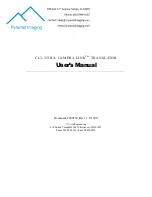
|
9
KeyStudio 49i User Guide
Hardware Connections
7
Audio Inputs
A dynamic microphone can be connected to the XLR input located on the rear panel, and an instrument such as a guitar or bass can
be connected to the 1/4” input jack, also located on the rear panel Each of these two inputs has an independent preamp featuring a
dedicated gain control knob, and level and clip LEDs Two analog RCA inputs are also located on the back panel Signal from these
inputs is mixed with the Microphone and Instrument inputs before being routed through the USB connection to a connected Mac
or PC
Audio Outputs
Connect the two analog 1/4” outputs (located on the rear panel of the KeyStudio) to powered monitors, an amplifier, or a mixer You
may also monitor through headphones by connecting one or two sets of headphones to the 1/4” stereo headphone outputs, located
on the front panel
MIDI Connections
In addition to the USB MIDI connection between KeyStudio 49i and your computer, you can connect the MIDI output of the
KeyStudio 49i to an external MIDI device’s MIDI input This enables you to control an external synthesizer or sound module via your
computer, using the KeyStudio as a USB to MIDI interface, or as a standalone MIDI controller keyboard
Other Connections
A sustain pedal can be connected to the 1/4” Sustain pedal jack on the back of KeyStudio
Connecting KeyStudio 49i to a Computer
8
KeyStudio 49i functions as a class-compliant device, and your computer will recognize the keyboard without additional drivers This
gives immediate access to all audio inputs and outputs as well as to the built-in MIDI interface As you become more familiar with the
KeyStudio keyboard, you may wish to take advantage of this product’s additional professional features by installing the KeyStudio 49i
drivers
In Windows, these additional features include: using your new keyboard with more than one application at the same time (multi-
client), sending large SysEx messages, or using your KeyStudio 49i with Pro Tools M-Powered recording software or the included
GM Module software Installing the KeyStudio ASIO drivers in Windows also improves audio performance by reducing the time it
takes for MIDI input (when using software synthesizers) or audio input signal to appear as audio at your computer’s outputs
On a Macintosh computer, installing the M-Audio drivers enables you to use your KeyStudio 49i with Pro Tools M-Powered recording
software
The Windows and Mac OS X drivers are found on the KeyStudio 49i CD-ROM included with this package











































